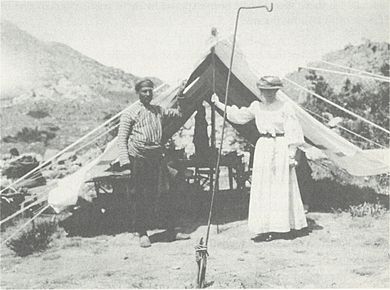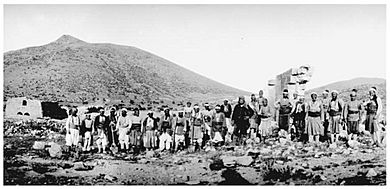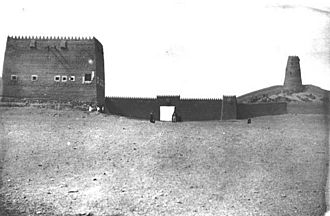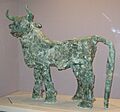Gertrude Bell facts for kids
Quick facts for kids
Gertrude Bell
|
|
|---|---|
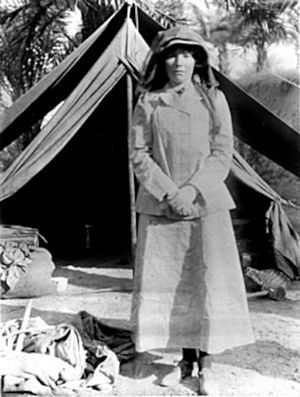
Gertrude Bell in 1909, visiting ancient ruins in Babylon
|
|
| Born |
Gertrude Margaret Lowthian Bell
14 July 1868 Washington New Hall, County Durham, England
|
| Died | 12 July 1926 (aged 57) |
| Nationality | British |
| Education | Lady Margaret Hall, Oxford |
| Occupation | Traveller, political officer |
| Era | Victorian, Edwardian – 1900s |
| Known for | Writer, traveller, political officer, archaeologist, explorer, cartographer in Syria-Palestine, Mesopotamia, Asia Minor, and Arabia |
| Parent(s) | Sir Hugh Bell
Mary Bell (née Shield)
|
Gertrude Margaret Lowthian Bell (born July 14, 1868 – died July 12, 1926) was an amazing English writer, explorer, and government official. She spent a lot of her life traveling and mapping the Middle East. She became very important in shaping British plans for the region because she knew so much about Arab cultures and had many friends there.
During her lifetime, British leaders like Percy Cox trusted her deeply, which gave her a lot of power. She helped make big decisions about the borders and governments of the Middle East after World War I. Bell believed that Arab people wanted their own countries, and that Britain should support them instead of fighting against them. Along with T. E. Lawrence, she helped create independent Arab states like modern-day Jordan and Iraq.
Gertrude Bell grew up in a wealthy family, which allowed her to study at Oxford University and travel the world. She met many important people who would later become leaders. During her travels, she became an excellent mountain climber and horseback rider. She loved the Middle East and visited places like Persia, Syria, Mesopotamia (now Iraq), and Arabia.
She also took part in archaeological digs, which are excavations to find ancient artifacts. She even paid for a dig herself at Binbirkilise in Asia Minor. She traveled through the Ha'il region in the northern part of the Arabian Peninsula in 1913–1914. She was one of the very few Westerners to see that area at the time.
When World War I started in 1914, and the Ottoman Empire joined the war on Germany's side, things changed a lot in the Middle East. Bell briefly worked with T. E. Lawrence in Cairo. In 1917, she joined the British government in Mesopotamia. She was a political officer, which meant she helped manage the area. She was the only woman in such a high position in the British Empire. Bell also supported the people of Iraq in their efforts to make their country modern.
She spent most of her later life in Baghdad and was key in helping to build the new country of Iraq. She made friends with many Iraqis and became a trusted advisor to Iraq's new King Faisal. Towards the end of her life, she was less involved in politics. King Faisal then made her the Honorary Director of Antiquities of Iraq. In this role, she went back to her love of archaeology. She helped improve how ancient finds were recorded and protected, which stopped people from stealing artifacts. She also supported education for Iraqi women, led the Baghdad library (which became the Iraq National Library), and started the Iraq Museum to show off Iraq's ancient treasures. She passed away in 1926.
Bell wrote many books. She translated a book of Persian poems and published several books about her travels and discoveries. She also sent many letters back to England during World War I. These letters helped the government understand the Middle East at a time when few English people knew much about it.
Contents
Early Life and Education
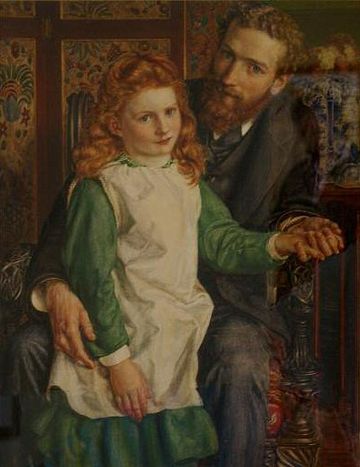
Gertrude Bell was born on July 14, 1868, in Washington New Hall, England. Her family was very rich, which allowed her to get a good education and travel. Her grandfather was a famous industrialist and a Member of Parliament.
Gertrude's mother died in 1871 when Gertrude was only three years old. This led to a very close relationship with her father, Sir Hugh Bell, 2nd Baronet. He was a fair boss who made sure his workers were paid well. Gertrude looked up to her father and often asked for his advice. He also shared his knowledge of government and introduced her to important officials.
When Gertrude was seven, her father remarried Florence Bell. Florence was a writer and helped Gertrude develop her intelligence by making sure she had excellent schooling. Florence's work helping the wives of factory workers might have inspired Gertrude to later support education for Iraqi women.
From 1883 to 1886, Gertrude Bell went to Queen's College, London, a top school for girls. At 17, she went to Lady Margaret Hall at Oxford University. History was one of the few subjects women were allowed to study back then. She focused on modern history and was the first woman to graduate from Oxford with top honors in Modern History, doing it in just two years. However, women were not given official degrees until 1920.
Adventures and Discoveries
Bell's uncle, Sir Frank Lascelles, was a British diplomat in Tehran, Persia. Bell visited him in May 1892 and stayed for about six months. She loved the experience, calling Persia "paradise." She wrote about her trip in her book Persian Pictures, published in 1894.
For the next ten years, she traveled the world, climbed mountains in Switzerland, and became passionate about archaeology and languages. She learned to speak Arabic, Persian, French, German, Italian, and Turkish fluently. In 1897, she published a respected translation of Persian poems. She had also ridden horses since she was young, which helped her on her travels.
In 1899, Bell returned to the Middle East. She visited Palestine and Syria. She met the Druze people living in Jabal al-Druze during a trip from Jerusalem to Damascus.
Between 1899 and 1904, she climbed many mountains, including La Meije and Mont Blanc. She found 10 new paths or first ascents in the Bernese Alps in Switzerland. One mountain peak, the Gertrudspitze, was named after her. She also climbed in the Rocky Mountains during a trip to North America in 1903.
In 1905, she went back to Greater Syria. She met Mark Sykes, another British traveler. They didn't get along at first but later became friends. She finished her trip by visiting ancient sites in Asia Minor and Constantinople. She wrote about her travels in the 1907 book Syria: The Desert and the Sown. This book described her journey through Syria, including Damascus, Jerusalem, and Beirut. The book was very popular. A tribesman once called her "Bint aarab," which meant "daughter of the desert," a compliment she loved.
In March 1907, Bell traveled to Asia Minor (now Turkey) and worked with Sir William M. Ramsay, an archaeologist. They dug up old Byzantine churches and buildings in Binbirkilise, which Bell helped fund. They wrote a book about their findings called A Thousand and One Churches.
In January 1909, Bell went to Mesopotamia. She visited the ancient city of Carchemish, photographed carvings, mapped ruins, and traveled to Babylon and Najaf. In Carchemish, she met archaeologists T. E. Lawrence and Reginald Campbell Thompson. She became good friends with Lawrence. Both Bell and Lawrence had studied history at Oxford, spoke Arabic, and traveled widely in the Arabian desert. She wrote a book about this journey, Amurath to Amurath.
In 1913, she completed her most challenging Arabian journey, traveling about 1800 miles from Damascus to the dangerous city of Ha'il, and then back to Baghdad and Damascus. She was only the second foreign woman to visit Ha'il. She was held prisoner in the city for eleven days before being released. At the end of her trip in Baghdad, Bell met Abd Al-Rahman Al-Gillani, who would become an important political figure later. Because of her travels, Bell was elected a member of the Royal Geographical Society in 1913 and received medals in 1914 and 1918.
Throughout her travels, Bell made strong connections with local people and tribes in the Middle East. She focused on meeting and getting to know the important male leaders and shaikhs.
World War I and Political Work
When World War I began in August 1914, and the Ottoman Empire joined the war a few months later, the British government asked Bell for her thoughts on the situation in Syria, Mesopotamia, and Arabia. She wrote a letter explaining how much the local people supported the British.
Bell volunteered with the Red Cross from 1914 to 1915, helping soldiers in France and London. She worked in a department that helped families find out about their loved ones who were injured or missing in the war.
Working in Cairo and Basra

In November 1915, Bell was called to Cairo, Egypt. She joined a group of British officials called the Arab Bureau. Here, she worked with T. E. Lawrence again. They organized information about Arab tribes and mapped the region, including water sources. This information was very useful to Lawrence during the Arab Revolt against the Ottoman Empire.
Bell's stay in Cairo was short. She was sent to British India in February 1916 to help the Arab Bureau work better with the Indian government. Lord Hardinge, the Viceroy of India and a family friend, was impressed by Bell's knowledge. She was then sent to Basra (which the British had captured) in March 1916. She worked for Percy Cox, a British political officer, as his Oriental Secretary. She was the only female political officer in the British forces.
In Basra, she traveled between Basra and Baghdad, learning about the local people's views. She wrote reports and drew maps to help the British Army advance on Baghdad. Bell met Ibn Saud in Basra in late 1916. She was impressed by him and wrote an article praising his skills as a leader.
Armenian Genocide Reports
While in the Middle East, Gertrude Bell reported on the Armenian genocide, a terrible event where many Armenians were killed. She wrote that these killings were much worse than any previous massacres. Bell also reported that in Damascus, Ottoman officials were openly selling Armenian women in the public market.
Creating the Country of Iraq
After British troops captured Baghdad in March 1917, Bell was called to the city. She was also given a special honor, Commander of the Order of the British Empire. When Percy Cox left Mesopotamia in 1918, Arnold Wilson took over. Bell and Wilson initially got along. Bell wrote a report in February 1919 about "Self-Determination in Mesopotamia," which meant letting the people decide their own future.
Bell visited France and England in 1919 and briefly attended the 1919 Paris Peace Conference. At this conference, plans were made to break up the Ottoman Empire and divide its territories. The Sykes–Picot Agreement had already decided that northern Syria would be under French influence. This left the British and Arabs to divide southern Syria, Mosul, Baghdad, and Basra.
By 1919, Bell became convinced that an independent Arab government in Mesopotamia, guided by British advisors, was the right way forward. She saw that a new Arab government in Syria, even with problems, seemed to bring peace. Meanwhile, in Egypt, there was a revolt against the British. Bell believed that if the British didn't keep their promise of self-rule, similar unrest would spread to Mesopotamia. She spent almost a year writing a detailed report called "Review of the Civil Administration of Mesopotamia."
Civil Commissioner Wilson disagreed with Bell. He preferred that an Arab government remain under direct British control because he felt the people of Mesopotamia were not ready to govern themselves peacefully. Problems arose, and Shia tribes in central Iraq revolted in the summer of 1920. Wilson blamed Arab propaganda for the revolt, but Bell blamed Wilson for not listening to local wishes.
On October 11, 1920, Percy Cox returned to Baghdad and replaced Wilson. Cox asked Bell to continue as his Oriental Secretary and work with the new Arab government. Cox brought back much of the old Ottoman government structure and appointed more Iraqis to lead local governments, though they still had strong British advisors.
Back in Britain, people were tired of war, and the British Empire was deeply in debt. British leaders, especially Winston Churchill, wanted to cut costs in the colonies. They realized that direct British rule was too expensive. The 1920 revolt had cost a lot of money and lives. It was clear that Iraq would be cheaper if it governed itself. Churchill called a meeting in Cairo to decide the future of British rule in the region.
The 1921 Cairo Conference
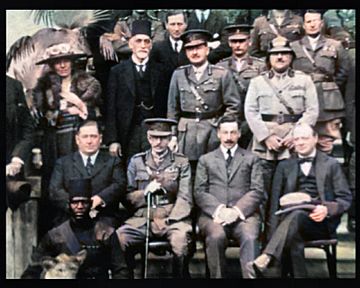
Standing first row, from left: Gertrude Bell, Sassoon Eskell, Edmund Allenby, Jafar Pasha al-Askari
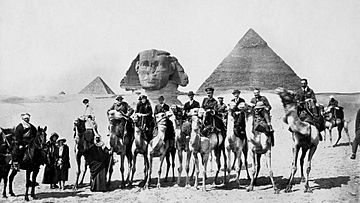
Bell, Cox, and Lawrence were among a small group of experts who met in Cairo to decide the borders of the new British-controlled territories. Few British officials knew much about Arab or Kurdish affairs, so Cox trusted Bell's advice. This gave her a lot of influence in these important discussions.
The British government had allowed France to control Syria, which complicated earlier promises to their Arab allies. The Arabs had hoped to lead a new large Arab state based in Damascus.
Different ideas for these lands were discussed, including continued direct British rule or independence. Bell, Cox, and Lawrence supported the idea of independent countries like Transjordan and Iraq. They also supported the idea that the sons of Hussein bin Ali, Sharif of Mecca, who started the Arab Revolt, should be the kings of these new countries. In this plan, Abdullah would be king of Jordan, and Faisal would be king of Iraq.
Bell believed that Faisal, as an outsider, could unite the new country of Iraq. She thought Shias would respect him because of his family line from Muhammad, and Sunnis would follow him because he was Sunni.
The Ottoman Empire had divided the region into three areas: Basra in the south, Baghdad in the center, and Mosul in the north (which was mostly Kurdish). These three areas had little connection under Ottoman rule. The question of what to do with oil-rich Mosul was a big debate. Bell argued for Iraq to include all three Ottoman territories, including Mosul. She eventually got her way after the conference. A vote was held to support Faisal as king, and enough Kurdish leaders agreed to include Mosul in Iraq.
Bell was against the Zionist movement, which aimed to create a Jewish state in Palestine. She wrote that she deeply mistrusted the Balfour Declaration, which supported a Jewish homeland in Palestine. She felt it was an "artificial scheme" that would lead to problems.
Advisor to King Faisal
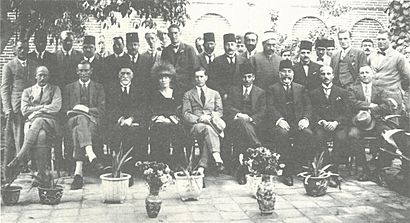
The plan to make Faisal king worked, and he was presented to Iraq as the new ruler. A local leader who opposed Faisal, Sayyid Talib, was arrested and sent away in April 1921. Bell had suggested this, seeing Talib as a potential troublemaker.
Bell worked in the British advisory group in Iraq throughout the 1920s. She was a key part of Iraq's government during Faisal's first years. When Faisal arrived in 1921, Bell advised him on local issues, including tribal leaders and businesses. Faisal became king of Iraq on August 23, 1921. Iraqis called Bell "al-Khatun," meaning "a Lady of the Court." She was a trusted friend to Faisal and helped him settle into his role.
Bell acted as a go-between for Faisal's government, British officials, and local leaders. She helped arrange meetings and parties, discussed current events with important people in Baghdad, and passed on requests and complaints to the government. She also suggested designs for the flag of Iraq and Faisal's personal flag.
The new Iraqi government had to balance the needs of different groups: Shias, Sunnis, Kurds, Jews, and Assyrian Christians. Keeping these groups happy was important for Iraq's stability and for British interests. A big goal was to create a new national identity so that all these people would feel like one nation.
One challenge for Faisal was gaining support from the Shia population. Faisal's government was mostly Sunni, which Bell supported. Bell found it hard to build close relationships with important Shia leaders because their beliefs prevented them from looking at an unveiled woman, and Bell did not wear a veil.
Bell found working with the new king difficult. She wrote in a letter in 1921, "You may rely upon one thing — I'll never engage in creating kings again; it's too great a strain."
National Library of Iraq
Muriel Jessie Forbes started the Baghdad Peace Library in 1919–20. Bell strongly supported the library and served as its President from 1921 to 1924. She helped raise money, asked British publishers for free books, and wrote articles for the library's review. The library started as a private library where people paid to borrow books. But because of money problems, the Ministry of Education took it over in 1924 and made it a public library. In 1926, it was one of only two public libraries in Iraq. It later became the National Library of Iraq.
Director of Antiquities
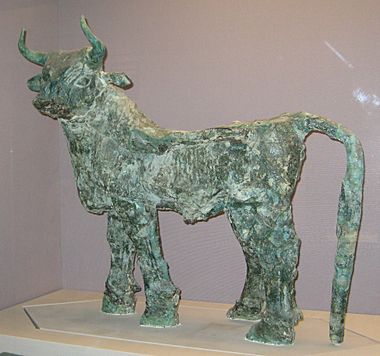
In October 1922, King Faisal appointed Bell as the Honorary Director of Antiquities. This job was perfect for her because of her experience and love for archaeology. Several important archaeological digs happened during her time, and Bell helped record and share the ancient finds. Leonard Woolley dug up the city of Ur from 1922–1934. In 1924, Bell invited archaeologist Edward Chiera to dig in ancient Nuzi, where many clay tablets with writing had been found.
New Laws for Ancient Treasures
Before Bell, rules for archaeological digs in the Ottoman Empire were messy. Digs happened without being registered, and there was no group to enforce rules. Bell's main job as Director of Antiquities was to create new laws. These laws would make it clear how to get permits for new digs, decide who owned discovered artifacts, and create a Department of Antiquities to enforce the law.
Bell's first ideas were seen as too favorable to British interests by Sati' al-Husri, Faisal's Director of Education. He was an Arab nationalist and slowed down the law's passage. But Bell's law passed in 1924 after some changes. It gave the Director (Bell herself) a lot of power to decide if discovered artifacts would stay in the national museum or be sent out of the country.
Bell's law helped bridge the gap between the old, chaotic way of doing archaeology and later laws that would give Iraq more control over its ancient treasures. Foreign archaeologists could still legally take artifacts from Iraq, but under stricter rules. Simply organizing and tracking digs helped reduce the illegal trade of stolen artifacts.
Baghdad Archaeological Museum
As Director of Antiquities, Bell was responsible for storing excavated artifacts. Her first storage room quickly filled up. She asked for a dedicated museum building in March 1923 but was initially turned down. After much effort, she finally secured a location for her museum in March 1926. This became the Baghdad Archaeological Museum, later renamed the Iraq Museum. It opened in June 1926, shortly before Bell's death.
Bell helped set up standard procedures for the museum: carefully keeping records of excavations and finds, using a numbering system to track them, and sending photos of unusual finds to the British Museum for more study. She did all this with a small but dedicated staff. Bell and her department helped protect Iraqi culture and history, including important relics from ancient Mesopotamian civilizations. The museum kept these treasures in their home country. Bell's will left money to the Iraq Museum and to the British Museum to start the "British School of Archaeology in Iraq" in London, which continued to fund digs.
Later Years and Legacy
The stress of writing many books and reports, along with frequent bronchitis from heavy smoking and attacks of malaria, took a toll on Bell's health. She became very thin in the 1920s and her health collapsed in 1924. She briefly returned to Britain in 1925, still unwell. She also corresponded with T. E. Lawrence, who asked for her advice on his book Seven Pillars of Wisdom. Her family's wealth began to decrease due to coal strikes in Britain. She returned to Baghdad and became ill with pleurisy. She then heard that her younger half-brother Hugo had died.
Many of Bell's close friends left Iraq in the early 1920s, including Percy Cox, who retired in 1923. She became good friends with Kinahan Cornwallis, another British advisor.
Bell struggled emotionally from 1923–1926 and may have been depressed. The new British High Commissioner, Henry Dobbs, consulted her less often than Percy Cox had. King Faisal also consulted her less after his first year. While she loved her new job as Director of Antiquities, she disliked being less involved in important government matters. In 1925, her beloved pet dog and Cornwallis's dog, whom she also cared for, both died.
On July 12, 1926, Gertrude Bell was found dead. She was buried in the Anglican cemetery in Baghdad the same day. Her funeral was a big event, attended by many people. It is said that King Faisal watched the procession from his balcony. In Great Britain, King George V personally sent a letter of sympathy to her parents.
How Gertrude Bell is Remembered
The borders of Iraq that were drawn during the partition of the Ottoman Empire, the 1921 Cairo Conference, and the addition of Southern Kurdistan in 1922 are still the borders of modern Iraq today. Many historians believe that including the Kurdish-dominated Mosul vilayet in Iraq was a mistake. Bell supported this inclusion, even though some of her friends like T. E. Lawrence disagreed. Bell had many Arab friends but fewer Kurdish friends, which might have made her too optimistic about including Kurdish lands in Iraq. She supported stopping Kurdish revolts in the 1920s and did not strongly advocate for special rights for the region. The division of Kurds among Iraq, Syria, Turkey, and Iran led to their struggles in all four countries.
Bell suggested that many parts of the government should be run locally, not just by the central government. She believed this was the only way to manage a country with many different ethnic and religious groups. Under her laws, local leaders in the countryside had broad power to collect taxes and manage justice. Later rulers preferred a strong, central government, and Bell's law was eventually canceled after the monarchy was overthrown in 1958.
Bell's work in archaeology and as Director of Antiquities is highly respected. Her photographs, notes, and detailed plans of sites she visited from 1909–1914 are "priceless records" that saved knowledge of many ancient buildings that have since been damaged or destroyed. A plaque honoring Bell was placed at the Archaeological Museum in 1930, after King Faisal asked for her memory to be honored.
Bell's work with the National Library of Iraq and the library of the National Museum of Iraq was praised for helping create some of the best libraries in the Middle East by the 1980s.
Tributes and Films
A special stained-glass window was made in her memory in St Lawrence's Church, England. It shows Oxford and Baghdad. The inscription remembers her as "Versed in the learning of the east and of the west, Servant of the State, Scholar, Poet, Historian, Antiquary, Gardener, Mountaineer, Explorer, Lover of Nature of Flowers and of Animals, Incomparable Friend Sister Daughter."
In the 2010s, a team from Newcastle University released a comic book about Bell's life.
In 2016, a campaign started to turn the Bell family's old home, Red Barns, into a memorial and museum. The house is a historic building and features wallpaper by William Morris.
The Gertrude Bell archive, a huge collection of her writings kept by Newcastle University, was added to the UNESCO Memory of the World Programme in 2017.
In 2019, scientists studying wild bees in Saudi Arabia named a new group of bees Belliturgula to honor Bell.
- In the 1992 TV film A Dangerous Man: Lawrence After Arabia, Bell is played by Gillian Barge.
- In the 2015 film Queen of the Desert by Werner Herzog, Bell is played by Nicole Kidman. This film tells much of Bell's life story.
- In the 2016 documentary Letters from Baghdad, Tilda Swinton reads parts of Bell's letters. The documentary uses Bell's and her friends' writings to tell her story.
Writings
Bell wrote a lot during her life. After she died in 1926, her stepmother Florence Bell chose some of her writings from over 2,400 pages of letters. In 1927, Florence published two books of Gertrude's letters, though she left out some personal letters and parts that might have embarrassed the Iraqi government. Since then, many other collections of Bell's letters, articles, and reports have been published.
Selected Works
- Persian Pictures (1896)
- Poems from the Divan of Hafiz (1897) – her translation of Persian poems
- Syria: The Desert and the Sown (1907)
- The Thousand and One Churches (1907) – with William M. Ramsay
- Amurath to Amurath (1911)
- The Palace and Mosque of Ukhaidir: A Study in Early Mohammadan Architecture (1914)
- The Letters of Gertrude Bell (1927) – edited by Lady Florence Bell
- The Arab war; confidential information for General headquarters from Gertrude Bell, being despatches from the secret "Arab bulletin" (1940) – edited by Kinahan Cornwallis
- Gertrude Bell: From Her Personal Papers (1961) – edited by Elizabeth Burgoyne
- The Churches and Monasteries of Tur'Abdin (1989) – edited by Marlia Mundell Mango
- A Woman in Arabia: The Writings of the Queen of the Desert (2015) – edited by Georgina Howell
Images for kids
See also
 In Spanish: Gertrude Bell para niños
In Spanish: Gertrude Bell para niños


